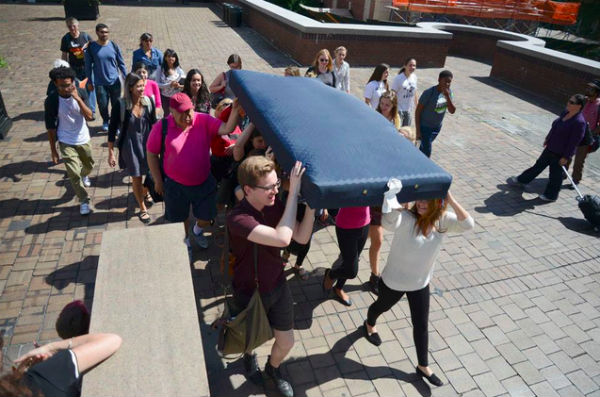Art & Exhibitions
Columbia Student’s Performance Art Catalyzes a Full-Fledged Protest Movement
Emma Sulkowicz's project is drawing major attention, both wanted and unwanted.
Emma Sulkowicz's project is drawing major attention, both wanted and unwanted.
The first two weeks of Emma Sulkowicz’s performance Mattress Performance: Carry That Weight at Columbia University could be taught in one of her classes as a lesson on the potentials—and potential pillfalls—of artistic protest in the age of viral media.
Since classes started at the beginning of the month, the Columbia University studio art major has embarked on a much-reported-upon action, conceived of as a symbol for the burdens faced by survivors of sexual assault. Saying that the university had allowed a man who raped her off the hook, Sulkowicz vowed to carry a twin mattress around campus until he left the school (see “Columbia Student’s Striking Mattress Piece”).
Shortly after the beginning of school—and the performance—she spoke to New York: “In the news, people have been calling my piece a protest, and just ignoring the fact it is not really a protest but a performance-art piece.” Mentioning Tehching Hsieh and Chris Burden’s work as precedents, she explained the artistic genesis of Mattress Performance:
Over the summer, I was lucky enough to get into the Yale Norfolk Residency, and I worked on a video where I had to move a mattress out of the room. The idea of carrying a mattress got stuck in my head the way a song gets stuck in your head, and I unpacked why carrying a mattress is an important visual for me. I thought about how I was raped in my own bed at Columbia; and how the mattress represents a private place where a lot of your intimate life happens; and how I have brought my life out in front for the public to see; and the act of bringing something private and intimate out into the public mirrors the way my life has been. Also the mattress as a burden, because of what has happened there, that has turned my own relationship with my bed into something fraught.
Sulkowicz is right that such details about the work’s artistic conception are as important as its immediate activist component, though the two dovetail. Among other things, the thoughtfully composed symbolism helps explain the way it has resonated well beyond its immediate context. As far away as the UK, the Telegraph quotes a reader floating the idea of an “International Carry That Weight Day.”
Meanwhile, on campus, activists have seized on the media ballyhoo around the performance, with dozens of student groups signing on to a letter to president Lee Bollinger suggesting ways the university can better deal with sexual assault. And on Friday hundreds came out on campus to protest the university’s policies and to have a public speak-out where students shared their own experiences with assault. In addition to cardboard signs, students held up whiteboards with slogans or wore symbolic red tape over their mouths.
But, inspired by Sulkowicz, the central symbol of the protest was the mattress, both piled up on the ground and used as banners, decorated with slogans including “Stand With Survivors,” “CU Has a Rape Problem,” and “Carry That Weight.”
The Columbia Spectator’s report from the scene offers the following vignette, giving a window into the on-campus climate that has caused Mattress Performance to take on such life:
Although many stepped up to share their thoughts, one of the more poignant moments came toward the end of the event when a student stepped out from behind the barricade of mattresses set up by the protesters to accept the megaphone being passed around.
“My name is Emily, and I’m a freshman,” she said. “I’ve been on this campus for two weeks and I was sexually assaulted six days ago. And nobody has told me where to go from there.”
Beyond the mattress itself, another symbolic element of Sulkowicz’s piece is worth noting. One of the “rules” of Mattress Performance: Carry That Weight is that she cannot herself ask for help in carrying the mattress, but can accept help if it is offered. This participatory dimension has opened a space for the performance to take on a new and moving type of meaning, as her peers organize “collective carry” events to assist, supporting Sulkowicz’s cause both physically and symbolically. In fact, a new student group Carry The Weight Together has been formed by another visual arts major, Allie Rickard, specifically to this end.

Students help Emma Sulkowicz carry her mattress
Photo via: Carry the Weight Facebook
Meanwhile, the frenzied attention has not always been so benign. Elle followed Sulkowicz around for a day, and reported on some of the more disorienting reactions to the piece:
Occasionally, students will come up to Sulkowicz to greet her as “Mattress Girl.” “They look at me like I’m this thing that popped out of the computer. I have to crack them,” she says. “I’m a real person.”
The media has, sometimes, been even worse. Sulkowicz told New York that at least one reporter had actually violated her physical space in his rush to get her attention, unzipping her backpack to put his card in while she was carrying the mattress. Another encounter is even more appalling:
I received an email from one reporter, “Subject line: Mattress Girl. Content: I have her contact info and I am going to get her.” I didn’t know that he was a reporter at first so I thought I was going to die, and so I was so scared and really fearing for my life. My boyfriend came and picked me up because I was so afraid of the reporters.
In a way, such unsettling details incidents another layer of meaning to the piece too, if an unwelcome one. It’s worth repeating the obvious: however powerful this artwork is as a symbol, reducing it to spectacle is to miss the point, disastrously.